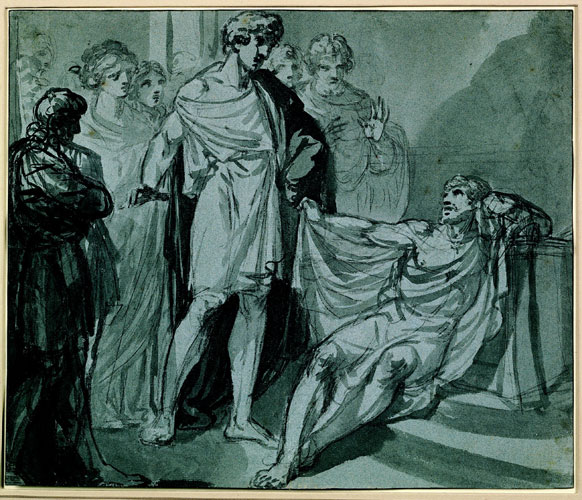Brush and black and grey ink over graphite on blue paper, with framing line in black ink. Size of sheet: 34.8 x 41.2 cm. Verso: Three sketchy renderings of an architectural character, perhaps a floor plan and a section of a wall. Also a numbering of the time G 2934. Signed on verso: J. B. Greuze.
Provenance: Maurice Delacre (1862 - Paris – 1938) (Lugt 747a); sale of his collection, Kornfeld & Cie, Berne 1944; bought by the family of the previous, Basle
Greuze has depicted here the celebrated encounter between Alexander the Great (356-323 B.C.) and the philosopher Diogenes of Sinope (ca. 400 – ca. 325 B.C.) as described in Diogenes's Laertius’s Lives of Eminent Philosophers (trans. Hicks, II, 20-81). Laertius, and also Plutarch, told how the triumphant Alexander visited the philosopher Diogenes, famed for his austerity, and invited him to ask any favor he chose. To everyone’s astonishment, Diogenes simply requested that the emperor stand aside, as he was shading him from the sun. Greuze suggests this request with the extended right arm of Diogenes.
"The present drawing should be dated to the period 1767 – 1769, when Greuze, banned from exhibiting at the Salon for not having submitted to the Academy his long-overdue Morceau de Réception decided to abandon his official status as a genre painter and become a history painter instead. During these two fruitful years, the artist experimented feverishly with a wide range of his historical subjects" (see Edgar Munhall, 'The Variety of Genres in the Work of Greuze. 1725 – 1805', in Journal in the Memorial Art Gallery of the University of Rochester, X/XI, 1987-88, pp. 25-27.), including another one dealing with Alexander the Great: Philip of Macedonia Threatening his Son Alexander.
The encounter of Alexander and Diogenes was depicted by a host of artists over the years: Caspar de Crayer, Sebastiano Ricci, Giovanni Battista Tiepolo, Gasparo Diziani. At the Salon exhibition Greuze missed, but surely saw - that of 1767 - the recently received Jean-Barnard Restout le fils exhibited his Diogenes Begging a Statue for Alms. The work elicited the ridicule of Diderot (“Où est l`ironie? Où est la fierté cynique?”), but it might have drawn the attention of Greuze to the subject of Diogenes and encouraged him to make more of it than his young colleague had.
But the most important representation of Alexander’s encounter with Diogenes available to Greuze was Pierre Puget’s monumental marble relief depicting the subject, which was housed in the Salle des Antiques at the Louvre (Louvre, 1996. vol II, p. 555 . (MR 2076)) from 1765 to 1792 and easily accessible to Greuze (see Musée du Louvre, 1996, II, p. 555 [MR 2076]). This work, an icon of the French sculptural tradition, provided a noble precedent for Greuze’s experiment.
Yet, finally, it was not the subject of Alexander and Diogenes that Greuze would depict in his long-awaited Morceau de Réception in 1769, but the more obscure confrontation of Septimius Serverus and Caracalla (Louvre). In his painted sketch for the canvas, Greuze employed the same fluid technique and somewhat abbreviated rendering of detail apparent in the present drawing, which is contemporary to it. Even the gesture of Septimus Servus pointing to his son echoes that of Diogenes requesting Alexander to move aside.
Edgar Munhall, New York, February 2005
